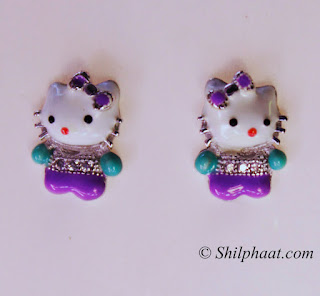 |
| Traditional Meenakari Jhumki |
The complete process is teamwork, requiring high level of precision. First the design of product is designed out of metal by metalsmith, then design is etched on the surface (nacqashi) by artisan called Nacquash who is specialized for the process. On next stage, meenakar or enameller applies powdered enamel or meena, in the grooves of the object. The enamel is applied on account of its heat resistance, most resistant is applied first. Each color of enamel is then fired , which melts enamel and helps it to spread evenly and fuse with the surface. After setting all colors of meena, object is cooled and polished for final look.
Besides Jaipur, Lucknow and Banaras are also important centers of enamalling or meenakari, each region has its own specialized technique, style and color choice for meenakari.
 |
| Trendy enameled earrings |
Just like every other art piece, meenakari is painstaking work that may take many hours or even days to complete. Meenakari works flourished during the Mughal and Rajput reign but now the craft is going through a rough phase as many Meenakars are leaving their professions in search of better options. Tough working conditions and low pay are to be blamed for this crisis.
References
1. http://cki.altervista.org/storia-smalto-eng.html
2. http://www.britannica.com/art/enamelwork
3. http://www.craftmark.org/sites/default/files/P037%20Meenakari.pdf
No comments:
Post a Comment
Note: only a member of this blog may post a comment.